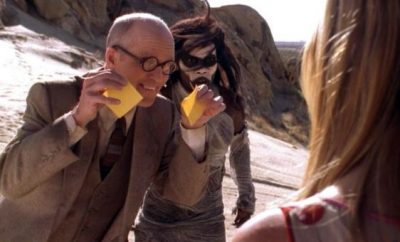
So, some time back I started writing blog posts in response to themes in Robert Alter’s The Pleasures of Reading in an Ideological Age. Then — you know, life — I lost momentum on it. But the other day I found myself on a website devoted to helping writers of speculative fiction, and read a couple of articles on the teasing subject of POV choice, and it reminded me of this chapter of Alter’s book, which was the chapter I found the most insightful of all of them, and which has borne a lot of influence on how I think about the question of perspective.
In fact, I recommend Alter’s book on the strength of this chapter alone, because among other things he takes the trouble to sketch the history of narratology both as practiced by writers and examined by critics. I can’t do justice to the entirety of his argument, so for this post I’ll just tackle two of his points: 1) That “the proliferation of narrative theory has brought with it a sometimes bewildering proliferation of competing views and terminologies,” which tends to garble both how we evaluate what we read and how we advise people to write, and 2) that “there is no hierarchy of narrative perspectives” and that great writing flows from an author’s choices of innovating or nuancing the “fluctuating play” of perspective, which gives “experiential depth and conceptual complexity” to the reader’s experience of the text.
Though I have lasting memories of graduate seminars in which diagrams and boxes were drawn (in chalk, because I am An Old) of narratological frameworks, the most sustained discussion of perspective and authorial choice I’ve encountered is in the arena of fanfiction. One reason for this is pretty obvious: the source text, the “canon,” of a book or TV show or film, has already got an array of established perspectives which the fanwork creator can either hew closely toward, or diverge from. Part of the pleasure, or lack of it, in reading and writing fanworks is to weigh the comparison with the source: is the author trying to match the canon? are they taking a different viewpoint of the same events? does the invention of an original character add perspective to the ‘verse?
Naturally, in an environment where lots of fiction is being written and read, there are undulating trends, and discussions of craft to go with them. For a long time, there was a prevailing trend of writing fanworks in tight third-person POV using the present tense — a trend which may parallel similar trends in modern original fiction, but in both cases was influenced by a small number of very skilled writers who used this perspective to great effect. The trend was and is so strong that in one of the articles on the site I linked above, the author actually recommended sticking to a close third-person perspective, as it was easier to master and also more desirable than “distant” third-person in terms of vivid and immediate wordcraft.
I…don’t agree with either of those assertions, and never have. Where to start? I guess I should start with what I absorbed as a young writer imitating different styles. I don’t remember reading a lot of tight-third stories, or at least not ones I wanted to emulate. What I read were stories with an omniscient narrator (Watership Down) and first-person narrators (To Kill a Mockingbird, Huckleberry Finn). Though I wasn’t attracted to tight-third perspective per se, the principle behind it certainly had its influence: namely, that really good fiction drew the reader into an encompassing reality, a world with immediacy, in which author intrusion was minimal.
Now, Richard Adams is so good that it was years before I noticed he’d written my favorite book in omni. And in part that was because he conceived the narrator of that story as a voice and perspective just as present as the rabbits whose journey he was following. But for the twentieth century it was an old-fashioned approach. The real cutting edge then was experimental perspectives that completely filled the frame and excluded the author-as-narrator to the greatest extent possible — Virginia Woolf, maybe, or James Joyce. Good writing became synonymous with that particular kind of immediacy, even bewilderment, that the reader was meant to share with the focal perspective of the text.
(Here’s a reason to read this chapter of Alter’s book if nothing else. He examines a passage of Joseph Conrad’s The Secret Agent — a book on the Edwardian Lit seminar syllabus that I did not enjoy, unlike The Man Who Was Thursday — and teases out the nuances of the perspective in a single pivotal paragraph, something that is not simply reportage or contextual storytelling or locked-in psychological sequence, but a threading of three needles at once. Alter reveals that one paragraph as a tour de force, and nails down his point that perspective is not a spreadsheet or a schematic. Gave me a better appreciation of Conrad’s abilities, too.)
I didn’t get much success with trying to write first-person narratives — an abandoned novel project and any number of first pages that never went anywhere. When I began to write fanfiction, however, I experimented with a perspective style I called “wide-angle” third (and which the Mythcreants author termed “distant” third — ye gods, the pejorative!) — and grew increasingly confident using it. I found it especially useful writing stories with an ensemble cast, using multiple POVs. Now, you can write ensemble casts in tight third POV, and a lot of people do. But for my purposes, I found it extremely useful for writing, say, Buffy Summers without having to present her thoughts as well as her dialogue in her inimitable voice. Especially if I was writing a story that also included the POV perspective of Giles, whose voice is, well, different. Too, I was writing stories with lots of angst, and there’s nothing worse for an angsty story than too much on-the-nose emoting. A wide-angle perspective, I reasoned, could give a reader the whole picture at any given time, without actually delving into omni.
I liked this so much that I actually went back to my first-person novel project and started it over with a wide-angle third perspective. It worked enough to reveal to me the real problem with the story, which was that it required some heavy research I didn’t care enough to do. So the story is still mothballed, but I feel less bad about it.
So, having written five hundred thousand words of fic (in one fandom) using wide-angle third, and having bridled at all the fandom praise being lavished on the opposite approach — and then getting over it, as one does — I was more or less free to consider what I wanted for my original fiction, with less arbitrary inward constraint or pressure of outward trends. For Ryswyck, I felt for and found a set of filters that would accommodate five very different POVs, which allowed for a bit more unabashed narration, especially when I wasn’t opening a scene with dialogue. Almost one of my first decisions in framing early drafts was to take a cinematic approach — or, something that would correspond to a cinematic approach if the story were being filmed: jump cuts, Sorkinesque walk-and-talks, repeated motifs: Speir being served a cup of tea on an artillery platform followed in the next scene by Douglas reaching for his cup on the desk — things that don’t have to be noticed, and are less apt to be noticed in a text medium, but which keep the eyeline steady from scene to scene.
And here’s a thing I miss about the old fandom venues: fic memes like “DVD commentaries,” in which the author of a fic interpolates comments on the process of a particular scene or story, including POV choices. It’s nice to discover (or tell) just what kind of on-purpose things a writer has done to achieve their effects.
Which brings me to the principle that undergirds all that I’ve learned about writing in the last twenty years. As a teaching assistant and adjunct instructor I used to tell students, “You have to know the rules to break them successfully,” and along with that goes its corollary: You can break almost any rule so long as you do it on purpose. That is — as the result of a decision process you came to about what would work better than any other technique in a given situation. This serves Alter’s larger point about how literary art is both craft and art, which can provide a reader with challenge and enjoyment, can speak to and evoke recognizable reality. If I were teaching now, I’d want my students to know something about the wider goals of using perspective, even as I drilled them on the disciplines of different perspective choices: how a take-six feels in the fencer’s hand, on the way to knowing without discursive thought when to use it in a bout.
Once you’ve encompassed that, the piste is wherever you say it is.
